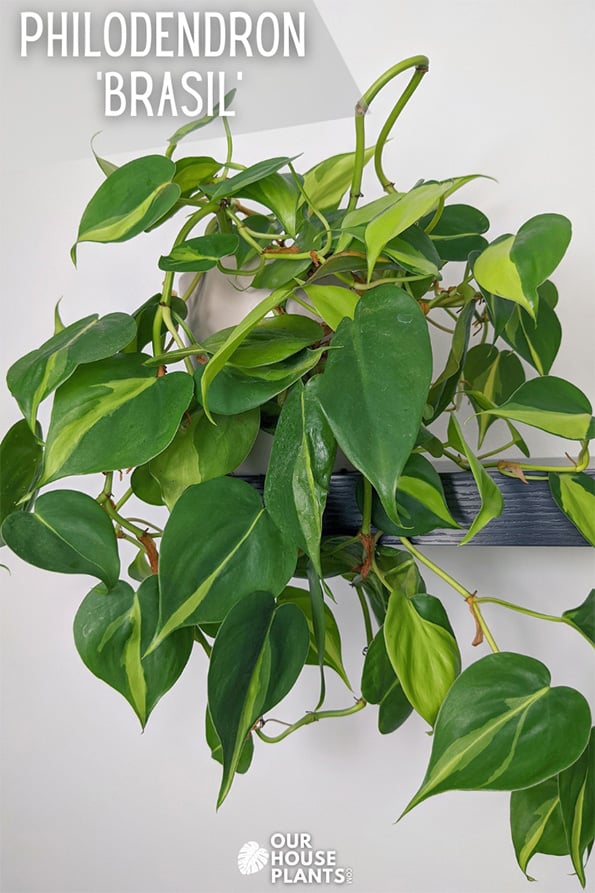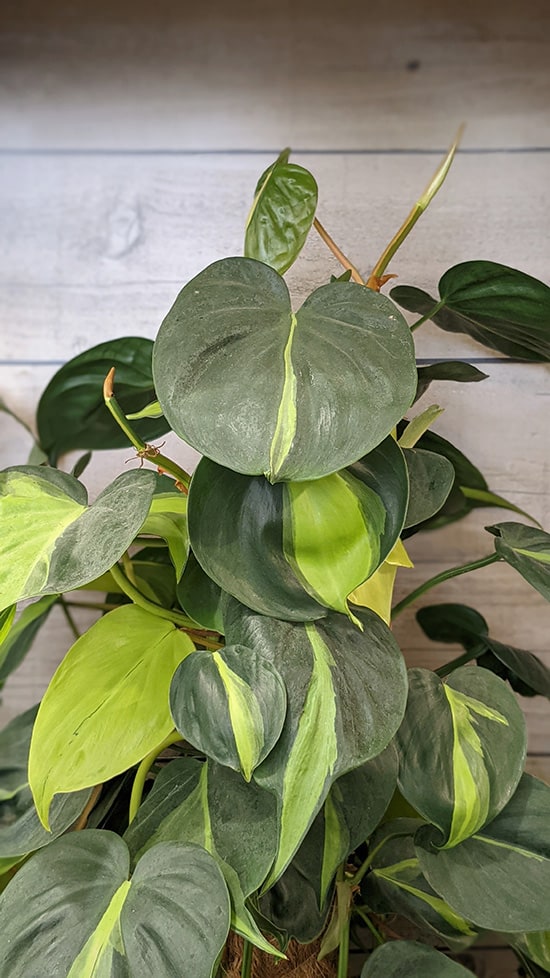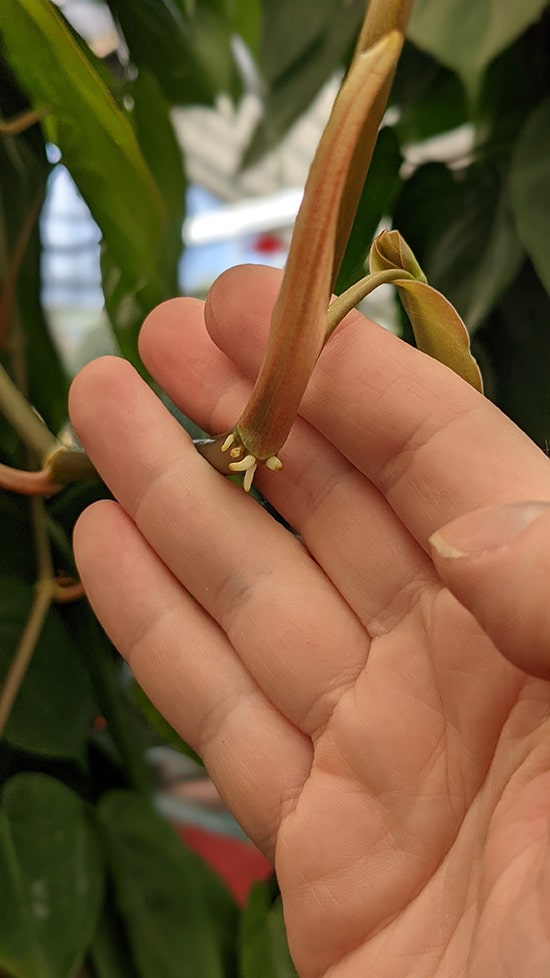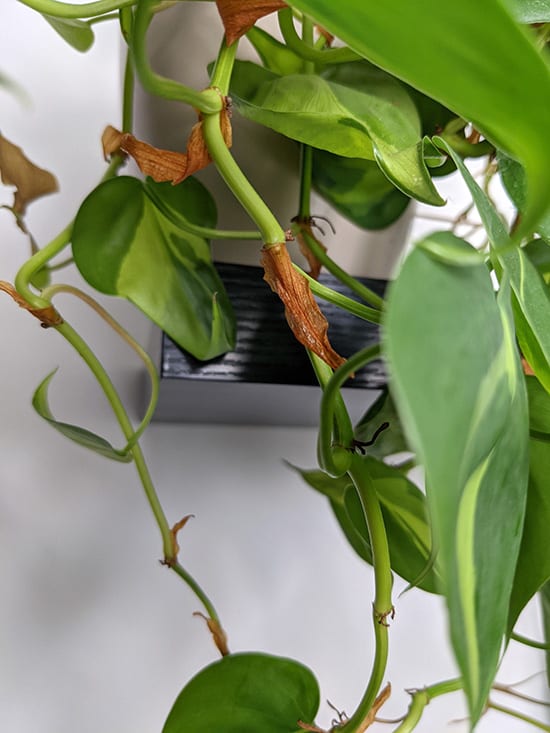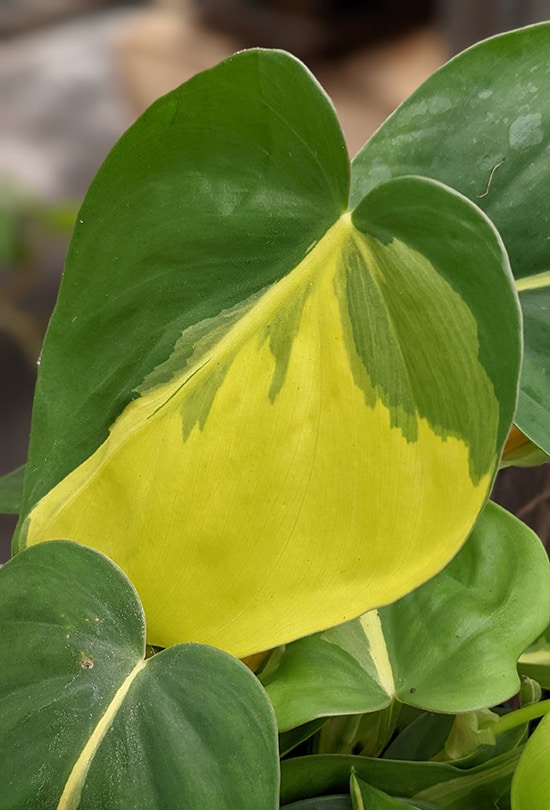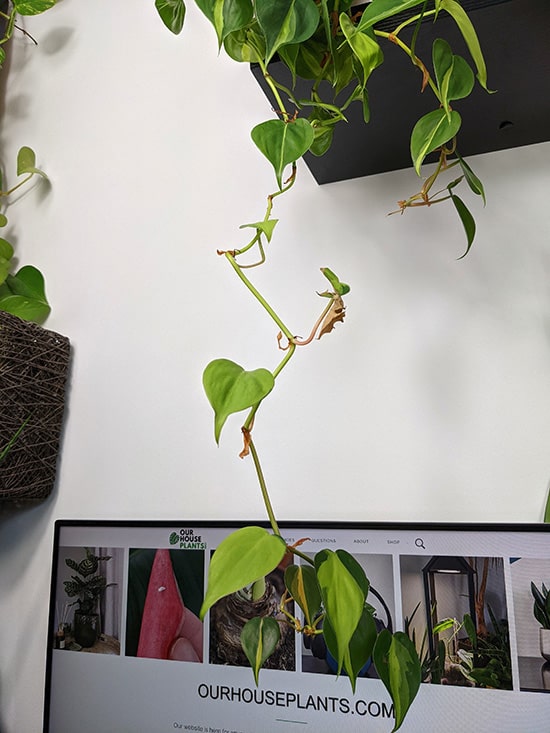If you're after a hanging plant, the Philodendron Brasil has got you covered with its beautiful trailing heart shaped leaves. If you like your indoor plants climbing tall up a moss pole, then the Brasil can do this instead if you want it to.
On top of this adaptability, it can also cope with almost any light situation you can provide. This is one very versatile philodendron and can be grown in many different ways.
Philodendron hederaceum 'brasil' can be encouraged to climb a moss pole / coconut coir totem, or allowed to trail from a shelf like this.
I've had my Philodendron Brasil for years and decided it was finally time to write a blog post on it. It's taken me so long to write about it because unfortunately, or fortunately, depending on how you look at things, the 'Brasil' is average in almost every way.
Anyone should be able to grow this plant perfectly well no matter their growing conditions (within reason). Because of this, I have very few secrets to share, hence my delay in writing about it. But I'm confident I'll still be able to teach you something new by the end of this article.
Did You Know?
One single plant with the familiar markings was discovered in Brazil in the 1990's.
This single plant was then propagated repeatedly, so every 'Brasil' you find today is a descendant of the original 1990's plant. How cool is that?
What we have here is a commonly found Philodendron houseplant, cheap to buy. An easy and perfect choice for beginners as well as those more experienced plant parents. It's also an adaptable plant that can climb a stake or trellis or left to trail over a shelf or ledge, depending on what you want it to do.
Although few would call it stunning, it has pretty semi glossy leaves and colorful markings to draw the eye. It's not a showstopper, but it doesn't make a fuss with its care needs and doesn't have a demanding nature. Sometimes, we just want to grow reliable and straightforward plants and the Philodendron 'Brasil' gives us these traits perfectly.
It deals well with lower light but can also cope with some higher light levels too. Propagation is simple to do and serious problems are unusual and in many cases easily resolved.
"Philodendron hederaceum" is a popular species from which several varieties are often grown as houseplants. It used to be known as "Philodendron scandens" so you will likely see plants going by this name, too. Rest assured, they're all from the same family of plants.
Although more varieties of hederaceum are sold, in general there are three that are the most popular.
- Philodendron hederaceum (Philodendron scandens) AKA - Heartleaf Philodendron
- Philodendron hederaceum 'Micans' (Philodendron scandens 'Micans')
- Philodendron hederaceum 'Brasil' (Philodendron scandens 'Brasil')
They're all great plants. I own all three and will have care guides for all shortly. But the subject of this post is the "Brasil" variety so the rest of the article focuses on this. It's a very distinctive plant, and I don't think you would easily confuse it with the other two.
All you need to look for is the lime green central stripe and when you see it you'll know you're looking at the "Brasil".
The Brasil is a fast-growing plant with small leaves, often covered in a lime green stripe of variegation.

Hi, I'm Tom!
If you're like me and enjoy the challenge of growing houseplants and getting them to thrive, then Ourhouseplants can help. This website shares my knowledge and years of growing plants and provides (hopefully) helpful advice on properly caring for your indoor plant friends.
The Philodendron 'Brasil' is highly adaptable with its light requirements and can adjust to pretty much anything. All you have to do is avoid extremely low light spots and intense midday sun.
Trying to grow them in these spots will eventually result in long leafless stems or sun damaged leaves with brown or black marks.
Think of "indirect light" being the middle of the road, and you can increase or decrease the light intensity from this point. This provides quite a range to pick from so most homes will be suitable for these plants.
Top Tip
Although they can deal with low light, providing stronger light levels will boost the speed of growth. So if you're looking for a fast growing plant, move it somewhere brighter.
As with many Philodendrons they don't like really wet soil around their roots. They can put up with some dryness for a few days if needed though, which is great if you neglect your plants from time to time.
The ideal goal should be to try and keep the compost moist from Spring until Autumn. Reduce this in winter when it will need less moisture and only needs watering when the top few inches have dried out.
Few people will have humidity related issues with these plants. Brown tips and leaf edges are fortunately rare even in lower humidity areas.
I only feed mine a few times a year, primarily over Spring and Summer. This helps support the active and visible growth you should be seeing over this period.
All I'm using are everyday general houseplant feeds, a few drops in the watering can and away you go. Heavy feeding (or not feeding at all) can encourage unusual variegation on the leaves.
The plant will produce growth if the temperature falls somewhere between 15°C (59°F) and 35°C (95°F). So for obvious reasons this should be the temperature range you should be providing during the growing seasons.
Top Tip
If you are trying to grow your plant quickly or want to root cuttings faster, higher temperatures will benefit this plant.
In Winter things slow down due to the reduced light levels, so the temperature is less important. However try to keep it somewhere above 10°C (50°F). Avoid frosts.
The root systems on the 'Brasil' are fairly thick but not overly robust or rigorous. Several cuttings will happily share the same container. This means repotting only needs to be done infrequently, perhaps every 2 or 3 years when the potting medium starts to break down.
If the plant stops growing or is clearly compacted, repot sooner.
You can grow your Brasil as a trailing plant or add in a support like a moss pole and watch it climb.
Philodendron hederaceum plants, including the 'Brasil' variety, are semi-epiphyte. This means the roots are adapted to being exposed to air but also prefer to anchor into something to absorb nutrients and water.
Generally speaking, it will be quite happy with a wide range of growing mediums, providing they let air in and don't get too compacted. Anything you use for your houseplants usually, should be fine here.
If this is your first houseplant, then everyday potting soil that is sold in most nurseries and big box stores should be fine. If the soil is being stored outside be careful because Fungus Gnats may have made it their home.
Stem cuttings are the best way to create more 'Brasil' plants. The best time to do it is during the growing season. So Spring or Summer. However, if you can provide warm temperatures, you can propagate at any point during the year. It will just take longer.
If you look at a vine you will typically have several inches of bare stem before you reach a leaf. This leaf has emerged from a "node" that will still be usable for proping.
Each vine will have multiple leaves and therefore multiple nodes you can use for propagation. You can create several plants from a single vine.
All you need to do is cut the vine just before and after the node, leaving you with a leaf and a small piece of vine, perhaps an inch or so long, with a node in the middle.
Want to see the process visually?
I created a YouTube Short when I propagated my Monstera adansonii. Although they're different plants the way to do it is exactly the same. Watch me here to understand the process.
Put the cutting into a glass of water (or directly into a suitable potting mix). With good light and warm growing temperatures you should see new roots emerging from the nodes after a few weeks.
The cutting should be established a month after you see the roots. At this point you can pot up into a suitable planter.
You can (and probably should) plant several cuttings into one container for a fuller and bushier look.
Philodendron brasil stem with roots forming from a leaf node, suitable for propagation.
It's normal to see aerial roots forming on vines like you can see in the photo above. It's absolutely fine to use this part of the plant for stem cutting propagation, and as a bonus, it should establish a little faster.
In warm or hot temperatures with medium or bright light, growth will be rapid. Over winter, plants grown in cooler temperatures or lower light areas will be noticeably slower to produce new leaves.
You can watch my Care Guide for the Philodendron Brasil over on YouTube.
Vines will grow and grow. After many years it's perfectly common to find them reaching lengths of 3 meters (10 feet) or longer. This lets you train them up walls or over furniture to get that jungle look.
You can of course prune them back before they get to this length. The pruned sections could also be propagated (see above) to create additional plants or gifts for friends.
White flowers will appear on occasion. Mainly on plants growing up moss poles and those that are pretty old (10 years plus).
The 'Brasil' like many Philodendrons contain calcium oxalate crystals. Pets would need to eat large amounts of the plant to become very unwell, but it's always best to play it safe if you know you own inquisitive pets.
Brown dried leaves / sheaths.
As the stem grows longer new leaves will emerge from nodes. The leaves are protected by a sheath. Once the leaf is out, the plant discards the sheath and goes brown on the vine. It's normal and not a problem or a sign of ill health. Just pull it off.
Brown leaf sheaths on a Philodendron are left over after the heart-shaped leaves have emerged.
Unstable Variegation.
For the most part leaves will have a predictable variegation pattern. A single lime green central stripe on each leaf. But sometimes this changes and you can have leaves displaying random and different variegation.
Whole leaves may change color or the stripe may expand to cover more than the central line, which you can see below.
It's normal for the variegated leaves to look different from one another depending on the growing conditions.
Why this happens is not certain, but the plant has an inbuilt ability for unstable variegation when certain environmental factors change. This isn't a sign of illness or disease and is actually just the plant flexing it's genetic range.
It's fairly common with most houseplants that have chimeric variegation. Although the Brasil is more reliable than other plants there is still a degree of unpredictability.
For example it's normal to buy a brand new nursery grown plant with many leaves that all have the traditional brasil markings. You get it home and a few months later new leaves are coming out differently.
It's generally thought that one or all of the following changes can alter how new leaves will look.
Most owners can only partially replicate the growing conditions provided by specialist growers. So my advice is not to worry about it. Each leaf has the potential for something different.
Sparse vines with few leaves.
Most plants you buy will have several cuttings in one pot to give an attractive bushy look. So if you separate and pull out a single vine like you can see in the photo, then it might give the impression of a problem.
In most cases, it's normal and not an issue.
However plants in very low light conditions may produce longer vines with larger spaces between each leaf and internode. If you notice this then check the light levels. If it's low move it somewhere with more light.
Stray vine hanging down from a shelf on a Philodendron scandens brasil. You can wrap the vine around the upper parts of the plant, this is especially helpful if you want a fuller plant. You can also remove it and prop new plants.
Thrips and Pests.
Unfortunately Thrips (Thunderflies) are attracted to Philodendrons including the Brasil. If you notice any mottling, unhealthy looking leaves, have a look for Thrips. They will be small tiny bugs, typically yellow, cream or black in color.
Commonly mistaken for dust or dirt, if you gently blow on them your breath will usually cause them to start moving. If it does then you have a Thrip problem that needs sorting ASAP.
Neem Oil is one method that can work, and insecticidal soap can help your brasil plant, but in most cases a stronger chemical is often needed to get rid of them completely.
